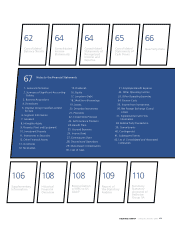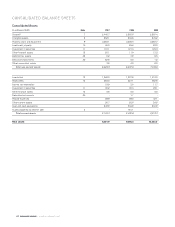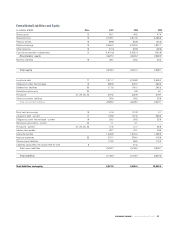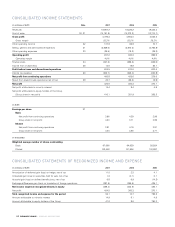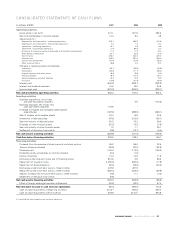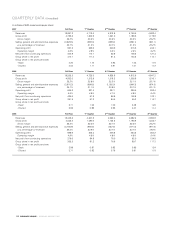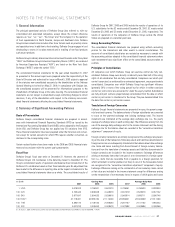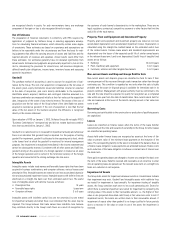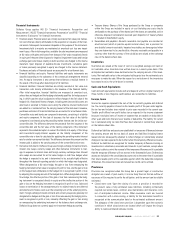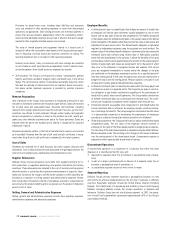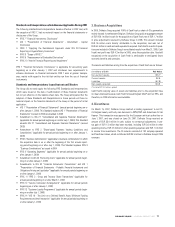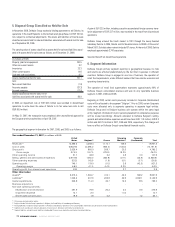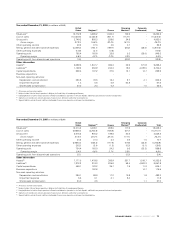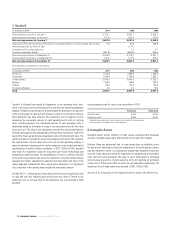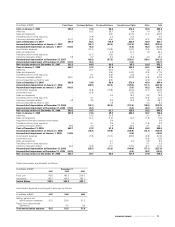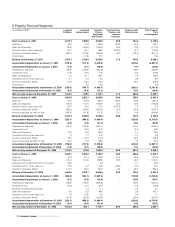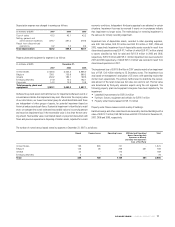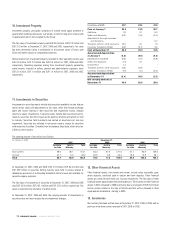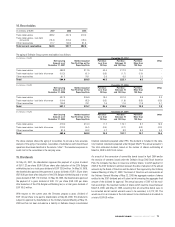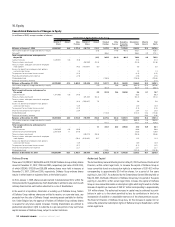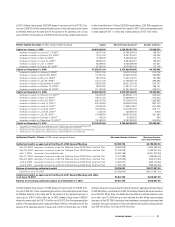Food Lion 2007 Annual Report Download - page 73
Download and view the complete annual report
Please find page 73 of the 2007 Food Lion annual report below. You can navigate through the pages in the report by either clicking on the pages listed below, or by using the keyword search tool below to find specific information within the annual report.
Standards and Interpretations which Became Applicable During 2007
The following standards and interpretations became effective in 2007 and, with
the exception of IFRS 7, had no material impact on the financial statements or
disclosures of the Group.
• IFRS 7 “Financial Instruments: Disclosures”
• IAS 1 “Presentation of Financial Statements” - Amendment - Capital
Disclosures
• IFRIC 7 “Applying the Restatement Approach under IAS 29 Financial
Reporting in Hyperinflatory Economies”
• IFRIC 8 “Scope of IFRS 2”
• IFRIC 9 “Reassessment of Embedded Derivatives”
• IFRIC 10 “Interim Financial Reporting and Impairment”
IFRS 7 “Financial Instruments: Disclosures” is applicable for accounting years
beginning on or after January 1, 2007 and introduces new requirements to
enhance disclosures on financial instruments. IFRS 7 aims at greater transpar-
ency, mainly with regard to the risk that entities run from the use of financial
instruments.
Standards and Interpretations Issued but not yet Effective
The Group did not early apply the following IFRS Standards and Interpretations
which were issued at the date of authorisation of these financial statements
but not yet effective on the balance sheet date. The Group anticipates that the
adoption of these Standards and Interpretations in future periods will have no
material impact on the financial statements of the Group in the period of initial
application:
• IAS 1 “Presentation of Financial Statements” (annual periods beginning on or
after January 1, 2009). This Standard replaces IAS 1 “Presentation of Financial
Statements” (revised in 2003) as amended in 2005
• Amendment to IAS 27 “Consolidated and Separate Financial Statements”
(applicable for annual periods beginning on or after July 1, 2009). This Standard
amends IAS 27 “Consolidated and Separate Financial Statements” (revised
2003)
• Amendment to IFRS 2 “Share-based Payment; Vesting Conditions and
Cancellations” (applicable for annual periods beginning on or after January 1,
2009)
• IFRS 3 “Business Combinations” (applicable to business combinations for which
the acquisition date is on or after the beginning of the first annual report-
ing period beginning on or after July 1, 2009). This Standard replaces IFRS 3
“Business Combinations” as issued in 2004
• IFRS 8 “Operating Segments” (applicable for annual periods beginning on or
after January 1, 2009)
• Amendment to IAS 23 “Borrowing Costs” (applicable for annual periods begin-
ning on or after January 1, 2009)
• Amendments to IAS 32 “Financial Instruments: Presentation” and IAS 1
“Presentation of Financial Statements - Puttable Financial Instruments and
Obligations Arising on Liquidation” (applicable for annual periods beginning on
or after January 1, 2009)
• IFRIC 11 “IFRS 2 : Group and Treasury Share Transactions” (applicable for
annual periods beginning on or after March 1, 2007)
• IFRIC 12 “Service Concession Arrangements” (applicable for annual periods
beginning on or after January 1, 2008)
• IFRIC 13 “Customer Loyalty Programmes” (applicable for annual periods begin-
ning on or after July 1, 2008)
• IFRIC 14 “IAS 19 - The Limit on a Defined Benefit Asset, Minimum Funding
Requirements and their Interaction” (applicable for annual periods beginning on
or after January 1, 2008)
3. Business Acquisitions
In 2005, Delhaize Group acquired 100% of Cash Fresh, a chain of 43 supermarkets
mainly located in northeastern Belgium. Delhaize Group paid an aggregate amount
of EUR 159.1 million in cash for the acquisition of Cash Fresh, net of EUR 1.7 million
in price adjustments received by Delhaize Group in 2006. This amount included
EUR 1.6 million costs directly attributable to the acquisition, and was net of
EUR 6.4 million in cash and cash equivalents acquired. Cash Fresh’s results of opera-
tions are included in Delhaize Group’s consolidated results from May 31, 2005. Cash
Fresh’s net profit was EUR 4.3 million in 2005, since the acquisition date. Goodwill
recognized on the acquisition of Cash Fresh is attributable to anticipated future
economic benefits and synergies.
The assets and liabilities arising from the acquisition of Cash Fresh are as follows:
(in millions of EUR)
Fair Value
Non-current assets 195.7
*
Current assets 22.9
Liabilities (57.8)
Net assets acquired 160.8
(*) Including EUR 143.3 million in goodwill
Cash Fresh’s carrying value of assets and liabilities prior to the acquisition have
not been disclosed because Cash Fresh followed Belgian GAAP and not IFRS, and
therefore, no IFRS information was available.
4. Divestitures
On March 15, 2007, Delhaize Group reached a binding agreement to sell Di,
its Belgian beauty and body care business to NPM/CNP and Ackermans & Van
Haaren. This transaction was approved by the European antitrust authorities on
June 1, 2007, and was closed on June 30, 2007. Delhaize Group received an
amount of EUR 33.4 million in cash, subject to contractual adjustments. A pre-
tax gain of EUR 1.5 million has been recorded, including EUR 3.0 million in other
operating income, EUR 2.5 million in other operating expenses and EUR 1.0 million
in income from investments. The Di network consisted of 132 company-operated
and franchised stores, which contributed EUR 95.5 million to Delhaize Group’s 2006
revenues.
DELHAIZE GROUP / ANNUAL REPORT 2007 71


